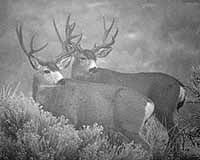| Many trophy bucks were seen during the hunt. |
The Emery County commission heard the Division of Wildlife Resources update at the Dec. 7 commission meeting. Derris Jones from the DWR said they support the seasonal road closures in the Pines on the Muddy drainage. These seasonal closures help with depredation and public safety problems. If the elk aren’t disturbed then they are less likely to come down into the haystacks by Ferron and Emery. The crossing of these elk on SR-10 is a safety issue for motorists.
Jones also said the land trade in Range Creek is moving forward with Hunt Oil, it is expected to be completed by the first of the year. The draft interim plan for Range Creek is about ready to be sent out for review and comments. This is a joint effort with Utah State Parks, University of Utah and the Museum of Natural History all having an interest.
Jones said the Gigliotti pond has been fitted with a synthetic lining which will take care of the leakage problem for good. Some aquatics money has been set aside for the development of community fisheries and the next such project will be at the fairgrounds in Price. The water will come from the North Carbon canal with watershares purchased from White Oak. If the clay isn’t good then a 2 acre pond will be constructed with a liner, but if the clay will hold the water then an 8 acre pond will be constructed. The vacancies in the aquatics department have been filled with highly qualified individuals who will bring an increased knowledge of the fish on the endangered species list and helpful suggestions for recovery efforts.
It was determined that the DWR will do a presentation at the public lands council meeting on Dec. 14 to discuss the endangered species and where and how the money is being spent to keep species off this list.
Jones said they are looking for additional funding for Duck Fork and hope to be taking fish eggs from the Colorado Cutthroat there a year from spring.
“Desert Lake is drying up and the future is not bright. With the installation of the irrigation systems in the area and the drought it’s hard to maintain it as a waterfowl management area,” said Jones. He said the DWR is thinking about purchasing water to put into the lake and wanted the commission to be aware of what was happening there and they are also open to suggestions. The commission advised they start with the irrigation company to inquire about any available water shares.
“The sagebrush habitat projects are down for the winter and will startup again in the spring. We are 200 acres short of the planned 700 acres for this year. The project includes seeding and aerating and the snow was keeping the machine too far off the ground to be effective so we’ll start again in the spring,” said Jones.
Jones mentioned the gas companies and the wildlife and working together to ensure the wildlife is protected with the development of gas wells. Commissioner Ira Hatch mentioned a comprehensive study recently released in Wyoming on the effects of the gas wells and wildlife. Jones said they haven’t studied the matter indepth, but he has found the deer tracks surrounding wells that are quieter and that noisier drilling operations seem to scare the deer off. Also, deer get used to the traffic when vehicles do not stop, but stopped vehicles tend to increase the deer’s heart rate and put them into a stressful situation. He said there are many factors involved in the declining deer population. The fawn production this year looked a lot better.
Sheep surveys were made on the south San Rafael and lamb production is up and adult animals will be counted in January.
Five new cases of chronic wasting disease were detected on deer taken in the LaSals on the rifle hunt. A study will be conducted this winter to study deer movements to see if the disease is transferring to any other areas.
The West Nile disease had less impact than expected and the drought may have been a contributing factor. In Wyoming the sage grouse have been affected by the West Nile virus and they have lost a lot of their population.
The deer hunt saw a substantial improvement in harvested bucks. Good, snowy conditions concentrated the bucks and more mature bucks were harvested and success was up. This might affect the buck/doe ratio of 15/1. Three consecutive years with reduced numbers requires that action be taken and the only action remaining to be taken in the southeastern region would be reduced permit numbers. These determinations will be made after the counts are in. The fawn/doe ratio looks good.
The Canadian Lynx in the area was captured by the Colorado Fish and Wildlife and will be released closer to its home at a later date. This was the third lynx identified this season one other was captured and one at the higher elevations of the Wasatch Front was left alone.
The elk hunting park in Carbon County had some escapee elk last season. An elk hunter this year harvested one of the animals which had a tag in its ear. The elk apparently went over a fence which had drifted with snow. One other elk with a tag in its ear was spotted by elk hunters and it is still wandering. These elk came from a farm in Colorado which has been tested for chronic wasting disease.
Sixty turkeys in boxes will be released in Spring Canyon.
The Carbon High science students will participate in the Adopt-a-flock program where they will help with the monitoring and data recording on the birds.

